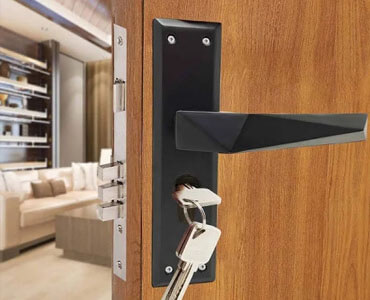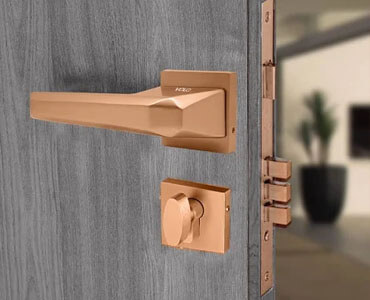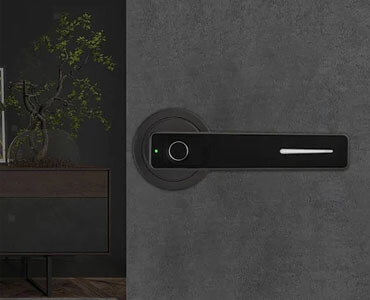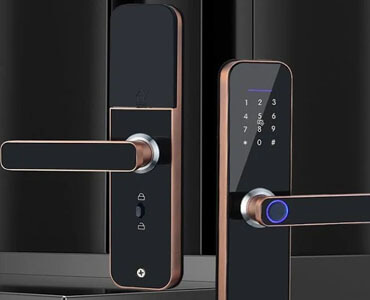Locks
Locks secure property from unauthorized access and protect items and equipment from theft. Padlocks are detachable locks that open with a key, a combination, Bluetooth technology, or a fingerprint. Padlock guards are placed over padlocks to protect them from cutting, prying, and smashing. Built-in locker locks install in locker doors so users don’t need to keep track of their own locks. Security cables and chains are used with padlocks to secure equipment that cannot be easily secured with a padlock alone. Cable locks are flexible cables that wrap around equipment and an anchor point and lock with a key or combination. Cam, cabinet, and drawer locks install in furniture to protect their contents.
Biometric padlocks restrict access to property and use fingerprints to unlock. Authorized users’ fingerprints are stored in the lock, so they don’t need to keep track of combinations or keys. These locks are used for storage lockers, workshops, garages, gates, and fences to prevent theft and unauthorized use of property.
Bluetooth padlocks are detachable locks that pass through an opening of a hasp or a link in a chain and are controlled with an app to restrict access to property. The Bluetooth technology requires a smartphone, but these locks eliminate the need for keeping track of keys or remembering padlock combinations. These padlocks also allow administrators to monitor and control access to keep goods safe from theft or unauthorized use. Bluetooth padlocks are commonly used when multiple people need access, such as in real estate and facilities management.
Built-in locker locks install on locker doors to restrict access to the property inside. They’re typically used in schools, gyms, health clubs, and spas so users don’t need to keep track of their own locks or keys. Control keys override the combination for combination locker locks and multiuser locker locks, so the locker can be opened if a user forgets the combination. Built-in multiuser locker lock instruction stickers and magnets are placed inside lockers to explain how the locks are used and prevent confusion for users who are unfamiliar with this style of lock.
Cable locks are flexible cables that wrap around equipment and an anchor point and lock with a key, combination, or both to prevent theft or unauthorized use. They’re used with items that cannot be secured with a padlock, like portable equipment, tools, bikes, and computers.
Cam, cabinet, and drawer locks install in furniture to protect the contents from theft and unauthorized use. Cam locks have an attached arm, or cam, that rotates to lock doors and drawers. Cabinet and drawer locks have bolts and latches for more security than cam locks. Cam lock master keys provide access to multiple master keyed cam locks with a single key.
Combination padlocks are detachable locks that pass through an opening of a hasp or a link in a chain and use a combination to restrict access to property, so users don’t need to keep track of keys to open them. They’re commonly used in schools, gyms, health clubs, or on luggage. Control keys are used with key-controlled combination padlocks to override the combination if it is forgotten or unknown.
Keyed padlocks and padlock keys are detachable locks that open with a key. They’re used across many applications to prevent unauthorized use, theft, or vandalism. Keyed padlocks are more secure than combination padlocks because they don’t have a dial that can be cracked with trial and error, and their overall construction prevents shimming. Keyed alike padlocks allow authorized users to open all padlocks in a set with the same key. Keyed different padlocks can only be accessed by one unique key. Master keyed padlocks can only be accessed by one unique key or a master key. Each padlock in the master system has its own key, which cannot be used on other padlocks, but a master key can open each lock in the set. Coreless keyed padlocks don’t have a core, allowing them to be rekeyed or keyed into an existing system by changing out a required cylinder core. Master keys open master keyed padlocks.
Padlock guards and padlock guards with locks are placed over padlocks to protect them from cutting, prying, and smashing. They help prevent theft and vandalism, and they also shield padlocks from harsh weather conditions that could damage and compromise the lock. They are typically used on exterior gates, fences, and doors. Padlock guards are used with existing padlocks. Padlock guards with locks include a padlock.
Security cables and chains are used with padlocks to secure fences, gates, doors, garages, and equipment that cannot be easily secured with a padlock alone. They help prevent theft and unauthorized property use in shops and at jobsites.





